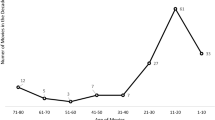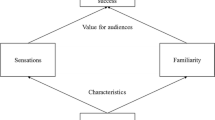Abstract
Studying children’s consumption behavior is a sensitive topic, especially in marketing, because children are often not the decision makers for the products and items they consume. Rather, the parents are the moderators and possessors of the purchasing power. Accordingly, parents’ prepurchase acceptance is a crucial determinant in the purchase decisions. Several factors related to the ethical content of children’s movies affect parents’ purchase decisions, including the level of emotional scenes that are depicted in a movie. This research aims to explore the effect of anomalous emotional scenes (AES) in children’s movies on the future revenues of production companies through parents’ acceptance/rejection rates and, consequently reactions to the AES. A total of 791 participants/parents from eight different countries participated by completing a questionnaire for the purpose of this study. Cultural and religious factors were taken into consideration to ensure cross-cultural results. The findings from the quantitative analysis of this study revealed that Anomalous Emotional Scenes perceived by parents in children’s movies negatively impact their demand because of ethical concerns, which are influenced by the cultural factor and not a religion factor. The negative impact consequently reduces potential new and repetitive purchases, which subsequently affects the incremental earnings of the company and thus reduces the overall revenues of the movie. Therefore, AES are a new additional factor that affects the revenues of children’s movies.


Similar content being viewed by others
References
Anderson, E. W., Fornell, C., & Lehmann, D. R. (1994). Customer satisfaction, market share, and profitability: Findings from Sweden. Journal of Marketing,58(3), 53–66.
Assadi, D. (2003). Do religions influence customer behavior? Confronting religious rules and marketing concepts. Cahiers Du CEREN,22, 5.
Bearden, W. O., & Etzel, M. J. (1982). Reference group influence on product and brand purchase decisions. Journal of Consumer Research,9(2), 183–194.
Brown, J. D., L’Engle, K. L., Pardun, C. J., Guo, G., Kenneavy, K., & Jackson, C. (2006). Sexy media matter: Exposure to sexual content in music, movies, television, and magazines predicts black and white adolescents’ sexual behavior. Pediatrics,117(4), 1018–1027.
Collin, P. H. (2010). Dictionary of banking and finance: Over 9,000 terms clearly defined (4th ed.). London: Bloomsbury Publishing.
Nell Minow (2008) Common Sense Media. [online]. https://www.commonsensemedia.org/movie-reviews/the-road-to-el-dorado. Accessed 23 Oct 2017.
Elberse, A. (2007). The power of stars: Do star actors drive the success of movies? Journal of Marketing,71(4), 102–120.
Engel, J. F., Blackwell, R. D., & Miniard, P. W. (1995). Consumer behavior (8th ed.). Fort Worth: Dryden.
Essoo, N., & Dibb, S. (2004). Religious influences on shopping behaviour: An exploratory study. Journal of marketing management,20(7–8), 683–712.
Houtkoop-Steenstra, H. (2000). Interaction and the standardized survey interview: The living questionnaire. Cambridge: Cambridge University Press.
Johnson, M. D., Anderson, E. W., & Fornell, C. (1995). Rational and adaptive performance expectations in a customer satisfaction framework. Journal of Consumer Research,21(4), 695–707.
Lachance, M. J., Beaudoin, P., & Robitaille, J. (2003). Adolescents’ brand sensitivity in apparel: Influence of three socialization agents. International Journal of Consumer Studies,27(1), 47–57.
Lindridge, A. (2005). Religiosity and the construction of a cultural-consumption identity. Journal of Consumer Marketing,22(3), 142–151.
Liu, Y. (2006). Word of mouth for movies: Its dynamics and impact on box office revenue. Journal of Marketing,70(3), 74–89.
Moon, S., Bergey, P. K., & Iacobucci, D. (2010). Dynamic effects among movie ratings, movie revenues, and viewer satisfaction. Journal of Marketing,74(1), 108–121.
Moon, J., Chadee, D., & Tikoo, S. (2008). Culture, product type, and price influences on consumer purchase intention to buy personalized products online. Journal of Business Research,61(1), 31–39.
Nash Information Services, 2018. The Numbers. [online]. Retrieved from: https://www.the-numbers.com/movie. Accessed 2 Jan 2018.
Okami, P. (1995). Childhood exposure to parental nudity, parent-child co-sleeping, and “primal scenes”: A review of clinical opinion and empirical evidence. Journal of Sex Research,32(1), 51–63.
Oxford Dictionaries. (2017a). Oxford Living Dictionary Press. [online] Oxford: Oxford University Press (UK). Retrieved from: https://en.oxforddictionaries.com/definition/french_kiss. Accessed 23 Dec 2017.
Oxford Dictionaries. (2017b). Oxford Living Dictionary Press. [online] Oxford: Oxford University Press (UK). Retrieved from: https://en.oxforddictionaries.com/definition/anomalous. Accessed 23 Dec 2017.
Pardun, C. J., L’Engle, K. L., & Brown, J. D. (2005). Linking exposure to outcomes: Early adolescents’ consumption of sexual content in six media. Mass Communication and Society,8(2), 75–91.
Patel, M. (2012). Influence of religion on shopping behaviour of consumers-an exploratory study. Abhinav National Monthly Refereed Journal of Research in Commerce & Management, 1(5), 68–78.
Picón, A., Castro, I., & Roldán, J. L. (2014). The relationship between satisfaction and loyalty: A mediator analysis. Journal of Business Research,67(5), 746–751.
Rich, M. (2005). Sex screen: The dilemma of media exposure and sexual behavior. Pediatrics,116(1), 329–331.
Roberts, J. A., Manolis, C., & Tanner, J. F., Jr. (2008). Interpersonal influence and adolescent materialism and compulsive buying. Social Influence,3(2), 114–131.
Simons, J., (1985). Youth marketing: Children’s clothes follow the latest fashion. Advertising Age, p. 16.
Solomon, M. R. (2012). Consumer behaviour buying, having, being (10th ed.). England: Pearson Education.
Solomon, M. R. (2015). Consumer behavior: Buying, having, and being. Edinburgh Gate: Pearson Education Limited.
Solomon, M. R. (2017). Consumer behavior: Buying, having, and being (12th ed., Vol. 10). England: Pearson Education.
Solomon, M. R. (2018). Consumer behaviour buying, having, being (12th ed.). England: Pearson Education.
Solomon, M. R., Bamossy, G., Askegaard, S., & Hogg, M. K. (2006). Consumer behaviour: A European perspective (3rd ed.). Edinburgh: Prentice Hall.
Spiro, R. L. (1983). Persuasion in family decision-making. Journal of Consumer Research,9(4), 393–402.
Strasburger, V. C., & Donnerstein, E. (1999). Children, adolescents, and the media: Issues and solutions. Pediatrics,103(1), 129–139.
The Public Authority for Civil Information (2018). Statistical report 2018. [online]. Retrieved from: http://stat.paci.gov.kw/englishreports/. Accessed 18 Apr 2019.
Villani, S. (2001). Impact of media on children and adolescents: A 10-year review of the research. Journal of the American Academy of Child and Adolescent Psychiatry,40(4), 392–401.
Vitelli, R. (2013). Television, commercials, and your child. Retrieved from http://www.psychologytoday.com/blog/media-spotlight/201307/television-commercials-and-your-child. Accessed 3 Feb 2018.
Author information
Authors and Affiliations
Corresponding author
Additional information
Publisher's Note
Springer Nature remains neutral with regard to jurisdictional claims in published maps and institutional affiliations.
Rights and permissions
About this article
Cite this article
Abdeltawab, A.M., Obaidalahe, Z. The effect of anomalous emotional scenes in children’s movies on future revenues. Eurasian Bus Rev 10, 475–492 (2020). https://doi.org/10.1007/s40821-019-00140-x
Received:
Revised:
Accepted:
Published:
Issue Date:
DOI: https://doi.org/10.1007/s40821-019-00140-x




